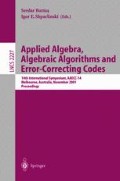Abstract
It is well-known that multiple transmit and receiving antennas can significantly improve the performance of wireless networks. The design of good modulation schemes for the model of multiple antenna wireless transmission in a fast fading environment (e.g., mobile communication) leads to an interesting packing problem for unitary matrices. Surprisingly, the latter problem is related to certain aspects of finite (and infinite) group theory. In this paper we will give a brief survey of some of these connections.
Access this chapter
Tax calculation will be finalised at checkout
Purchases are for personal use only
Preview
Unable to display preview. Download preview PDF.
References
S. M. Alamouti. A simple transmitter diversity scheme for wireless communications. IEEEJ. Sel. Area Comm., pages 1451–1458, 1998.
Th. Bröcker and T. tom Dieck. Representations of Compact Lie Groups. Number 98 in Graduate Texts in Mathematics. Springer Verlag, New York, 1985.
W. Burnside. On a general property of finite irreducible groups of linear substitutions. Messengerof Mathematics, 35:51–55, 1905.
K. L. Clarkson, W. Sweldens, and A. Zheng. Fast multiple antenna differential decoding.Technical report, Bell Laboratories, Lucent Technologies, October 1999. Downloadable fromhttp://mars.bell-labs.com.
G. J. Foschini. Layered space-time architecture for wireless communication in a fadingenvironment when using multi-element antennas. Bell Labs. Tech. J., 1(2):41–59, 1996.
J. Hamkins and K. Zeger. Asymptotically dense spherical codes. IEEE Trans. Info. Theory,43:1774–1798, 1997.
B. Hassibi and M. Khorrami. Fully-diverse multiple-antenna signal constellations and fixed-point-free Lie groups. Submitted to IEEE Trans. Info. Theory. Downloadable from http://mars.bell-labs.com, 2000.
B. Hochwald and W. Sweldens. Differential unitary space time modulation. Technical report,Bell Laboratories, Lucent Technologies, Mar. 1999. Also submitted to IEEE Trans. Comm.Downloadable from http://mars.bell-labs.com
B. M. Hochwald and T. L. Marzetta. Unitary space-time modulation for multiple-antennacommunication in Rayleigh flat-fading. to appear in IEEE Trans. Info. Theory, Mar. 2000.Downloadable from http://mars.bell-labs.com.
B. Hughes. Optimal space-time constellations from groups. Submitted to IEEE Trans. Info.Theory, 2000.
H. Jafarkhani and V. Tarokh. Multiple transmit antenna differential detection from generalizedorthogonal designs. 2000. Preprint, AT&T.
Xue-Bin Liang and Xiang-Gen Xia. Unitary signal constellations for differential space-timemodulation with two transmit antennas: Parametric codes, optimal designs, and bounds. 2001.Preprint.
A. Shokrollahi. Computing the performance of unitary space-time group constellations fromtheir character table. In Proceedings of ISIT 2001, Washington DC, 2001. Preprint downloadablefrom http://mars.bell-labs.com.
A. Shokrollahi. Design of unitary space-time codes from representations of SU(2).In Proceedings of ISIT 2001, Washington DC, 2001. Preprint downloadable from http://mars.bell-labs.com.
A. Shokrollahi. A note on 2-dimensional diagonal space-time codes. In Proceedings ofISIT 2001, Washington DC, 2001. Preprint downloadable from http://mars.belllabs.com.
A. Shokrollahi, B. Hassibi, B. Hochwald, and W. Sweldens. Representation theory for highratemultiple-antenna code design. IEEE Trans. Inform. Theory, 2001. To appear. Preprintdownloadable from http://mars.bell-labs.com.
J. Stilwell. The story of the 120-cell. Notices of the AMS, 48:17–24, 2001.
V. Tarokh, N. Seshadri, and A. R. Calderbank. Space-time codes for high data rate wirelesscommunication: Performance criterion and code construction. IEEE Trans. Info. Theory,44:744–765, 1998.
I. E. Telatar. Capacity of multi-antenna gaussian channels. Technical report, Bell Laboratories,Lucent Technologies, 1995.
H. Zassenhaus. Über endliche Fastkörper. Abh. Math. Sem. Hamburg, 11:187–220, 1936.
Author information
Authors and Affiliations
Editor information
Editors and Affiliations
Rights and permissions
Copyright information
© 2001 Springer-Verlag Berlin Heidelberg
About this paper
Cite this paper
Shokrollahi, A. (2001). Design of Differential Space-Time Codes Using Group Theory. In: Boztaş, S., Shparlinski, I.E. (eds) Applied Algebra, Algebraic Algorithms and Error-Correcting Codes. AAECC 2001. Lecture Notes in Computer Science, vol 2227. Springer, Berlin, Heidelberg. https://doi.org/10.1007/3-540-45624-4_3
Download citation
DOI: https://doi.org/10.1007/3-540-45624-4_3
Published:
Publisher Name: Springer, Berlin, Heidelberg
Print ISBN: 978-3-540-42911-1
Online ISBN: 978-3-540-45624-7
eBook Packages: Springer Book Archive

